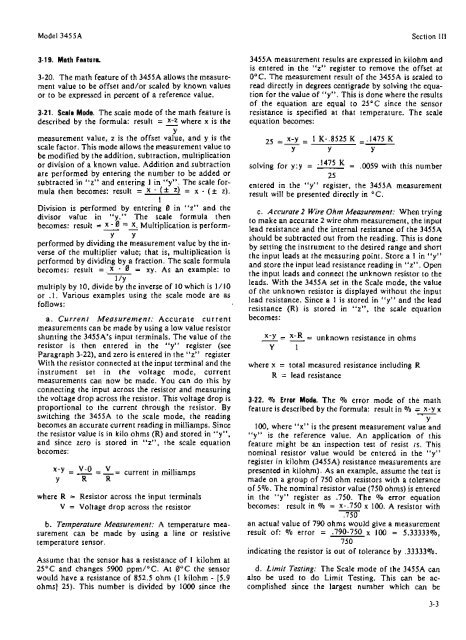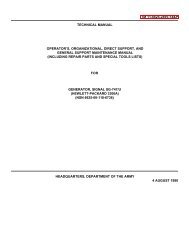You also want an ePaper? Increase the reach of your titles
YUMPU automatically turns print PDFs into web optimized ePapers that Google loves.
Model 3455A Section I11<br />
3-20. The math feature of th 3455A allows the measure-<br />
ment value to be offset and/or scaled by known values<br />
or to be expressed in percent of a reference value.<br />
3.21. Sale Mods. The scale mode of the math feature is<br />
described by the formula: result = X-Z where x is the<br />
Y<br />
measurement value, z is the offset value, and y is the<br />
scale factor. This mode allows the measurement value to<br />
be modified by the addition, subtraction, multiplication<br />
or division of a known value. Addition and subtraction<br />
are performed by entering the nurnber to be added or<br />
subtracted in "2" and entering 1 in "y". The scale for-<br />
muIa then becomes: result = x - (* d = x - ( f z).<br />
1<br />
Division is performed by entering 0 in "z'9ad the<br />
divisor value in "y." The scale formula then<br />
becomts: result = 5 -5 Multiplication is perform-<br />
Y Y<br />
performed by dividing the measurement value by the in-<br />
verse of the multipIier value; that is, multiplication is<br />
performed by dividing by a fraction. The scale formula<br />
becomes: result = . X - 0 = xy. As an example: to<br />
1 /Y<br />
multiply by 10, divide by the inverse of 10 which is 1/10<br />
or .I. Various examples using the scale mode are as<br />
follows:<br />
a. Current Measurement: Accurate current<br />
measurements can be made by using a low value resistor<br />
shunting the 3455A's input terminals. The value of the<br />
resistor is then entered in the '"y" register (see<br />
Paragraph 3-22), and zero is entered in the "z" register<br />
Wirh the resistor connected at the input terminal and the<br />
instrument set in the voltage mode, current<br />
measurements can now be made. You can do this by<br />
connecting the input across the resistor and measuring<br />
the voltage drop across the resistor. This voltage drop is<br />
proportional to the current through the resistor. By<br />
switching the 3455A to the scale mode, the reading<br />
becomes an accurate current reading in rnilliamps. Since<br />
the resistor value is in kiIo ohms (R) and stored in "y",<br />
and since zero is stored in "z". the scale equation<br />
becomes:<br />
v-0 v<br />
X'Y = - = -= current in rnilliamps<br />
Y R R<br />
where R = Resistor across the input terminaZs<br />
V = Voltage drop across the resistor<br />
b. Temperature Measurement: A temperature mea-<br />
surement can be made by using a line or resistive<br />
temperature sensor.<br />
Assume that the sensor has a resistance of 1 kiIohrn at<br />
25°C and changes 5900 ppm/"C. At 0'C the sensor<br />
would have a resistance of 852.5 ohm (1 kilohm - 15.9<br />
ohms) 25). This number is divided by 1000 since the<br />
3455A measurement results are expressed in kilohrn and<br />
is entered in the "2" register to remove the offset at<br />
0°C. The measurement result of the 3455A is scaled ?a<br />
read directly in degrees centigrade by solving the equa-<br />
tion for the value of "y". This is done where the results<br />
of the equation are equal to 25°C since the sensor<br />
resistance is specified at that temperature. The scale<br />
equation becomes:<br />
solving for y:y = = -12459 with this number<br />
25<br />
entered in the "y" register, the 3455A measurement<br />
result will be presented directly in "C.<br />
c. Accurate 2 Wire Ohm Memrement: When trying<br />
to make an accurate 2 wire ohm measurement, the input<br />
lead resistance and the internal resistance of the 3455A<br />
should be subtracted out from the reading. This is done<br />
by setting the instrument to the desired range and short<br />
the input leads at the measuring point. Store a 1 in "y"<br />
and store the input lead resistance reading in "z". Open<br />
the input Ieads and connect the unknown resistor to the<br />
leads. With the 3455A set in the Scale mode, the value<br />
of the unknown resistor is displayed without the input<br />
lead resistance. Since a 1 is stored in "y" and the lead<br />
resistance (RE is stared in "z", the scale equation<br />
becomes:<br />
x-y =<br />
Y 1<br />
= unknown resistance in ohms<br />
whwe x = total measured resistance incIuding R<br />
R = lead resistance<br />
3.22. % Error Mods. The % error mode of the math<br />
feature is described by the formula: result in % = z x<br />
Y<br />
100, where "x" is the present measurement value and<br />
"y" is the reference value. An application of this<br />
feature might be an inspection rest of resist rs. This<br />
nominal resistor value would be entered in the "y"<br />
register in kilohrn (3455A) resistance measurements are<br />
presented in kiIohm). As an example, assume the test is<br />
made on a group of 750 ohm resistors with a tolerance<br />
of 5Vo. The nominal resistor value (750 ohms) is entered<br />
in the "y" register as .750. The % error equation<br />
becomes: result in To = x--750 x 100, A resistor with<br />
.750<br />
an actual value of 790 ohms would give a measurement<br />
result of: % error = .7W-750 x 100 = 5.33333%,<br />
750<br />
indicating the resistor is out of tolerance by -33333%.<br />
d. Limit Tmting: The Scale mode of the 345SA can<br />
also be used to do Limit Testing. This can be ac-<br />
complished since the largest number which can be



